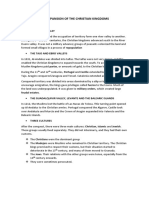0 ratings0% found this document useful (0 votes)
9 viewsChem Lee
Chem Lee
Uploaded by
Lee Alvin MagyayaElectrolyte solutions have a greater effect on colligative properties than nonelectrolyte solutions because electrolytes dissociate into multiple particles when dissolved, increasing the number of solute particles in solution. Nonelectrolytes do not dissociate so they have less of an effect. The key colligative properties - vapor pressure lowering, boiling point elevation, freezing point depression, and osmotic pressure - all increase with higher solute concentration as more solute particles take up space that would otherwise be occupied by solvent molecules.
Copyright:
© All Rights Reserved
Available Formats
Download as DOCX, PDF, TXT or read online from Scribd
Chem Lee
Chem Lee
Uploaded by
Lee Alvin Magyaya0 ratings0% found this document useful (0 votes)
9 views3 pagesElectrolyte solutions have a greater effect on colligative properties than nonelectrolyte solutions because electrolytes dissociate into multiple particles when dissolved, increasing the number of solute particles in solution. Nonelectrolytes do not dissociate so they have less of an effect. The key colligative properties - vapor pressure lowering, boiling point elevation, freezing point depression, and osmotic pressure - all increase with higher solute concentration as more solute particles take up space that would otherwise be occupied by solvent molecules.
Original Title
CHEM-LEE
Copyright
© © All Rights Reserved
Available Formats
DOCX, PDF, TXT or read online from Scribd
Share this document
Did you find this document useful?
Is this content inappropriate?
Electrolyte solutions have a greater effect on colligative properties than nonelectrolyte solutions because electrolytes dissociate into multiple particles when dissolved, increasing the number of solute particles in solution. Nonelectrolytes do not dissociate so they have less of an effect. The key colligative properties - vapor pressure lowering, boiling point elevation, freezing point depression, and osmotic pressure - all increase with higher solute concentration as more solute particles take up space that would otherwise be occupied by solvent molecules.
Copyright:
© All Rights Reserved
Available Formats
Download as DOCX, PDF, TXT or read online from Scribd
Download as docx, pdf, or txt
0 ratings0% found this document useful (0 votes)
9 views3 pagesChem Lee
Chem Lee
Uploaded by
Lee Alvin MagyayaElectrolyte solutions have a greater effect on colligative properties than nonelectrolyte solutions because electrolytes dissociate into multiple particles when dissolved, increasing the number of solute particles in solution. Nonelectrolytes do not dissociate so they have less of an effect. The key colligative properties - vapor pressure lowering, boiling point elevation, freezing point depression, and osmotic pressure - all increase with higher solute concentration as more solute particles take up space that would otherwise be occupied by solvent molecules.
Copyright:
© All Rights Reserved
Available Formats
Download as DOCX, PDF, TXT or read online from Scribd
Download as docx, pdf, or txt
You are on page 1of 3
Lee Alvin M.
Magyaya General Chemistry 2
Grade 12 STEM - Euclid Mrs. Mary Rose Decena
Activity No. 2
Differentiate the colligative properties of nonelectrolyte solutions and of electrolyte solutions
Colligative Properties of Electrolytes vs Nonelectrolytes
Electrolyte Solutions Solutes Effect on Colligative
Properties
The physical characteristics By dissociating, electrolytes The effect of electrolytes on
of electrolytic solutions that add more solutes to the colligative properties is very
rely on the quantity of solution, significantly altering high compared to
solutes, irrespective of the the colloidal characteristics. nonelectrolytes.
kind of solutes, are known as
coagulative properties of
electrolytes.
Nonelectrolyte Solutions Solutes Effect on Colligative
Properties
Nonelectrolyte collitive Since nonelectrolytes do not The effect of nonelectrolytes
properties are the physical dissociate, they add little on colligative properties is
characteristics of non- solute to the solution, which very low compared to
electrolyte solutions that rely does not significantly alter electrolytes.
on the quantity of solutes, their collagative properties.
irrespective of the kind of
solutes.
Lee Alvin M. Magyaya General Chemistry 2
Grade 12 STEM – EUCLID Mrs. Mary Rose Decena
Activity No. 1
Describe the effect of concentration on the colligative properties of solution.
Colligative Properties of Solution Effects of Concentration
In a pure solvent, the solvent's molecules
cover the entire surface area. The amount of
solvent molecules covering the surface
decreases if a non-volatile solute is introduced
to the solvent, making the surface contain
Lowering of Vapour Pressure both solute and solvent molecules. At the
same temperature, the vapour pressure of the
solution is found to be lower than that of the
pure solvent because the vapour pressure of
the solution is primarily caused by the solvent.
The temperature at which the vapour pressure
equals atmospheric pressure is known as a
liquid's boiling point. We are aware that the
vapour pressure of a solution decreases when
a non-volatile liquid is added to a pure
Elevation in Boiling Point solvent. Therefore, we must raise the
solution's temperature in order to bring the
vapour pressure to atmospheric pressure.
Elevation in boiling point is the term used to
describe the difference between the boiling
point of the solution and the boiling point of
the pure solvent.
The temperature at which a substance's
vapour pressure in its liquid phase equals that
substance's vapour pressure in its solid phase
is known as the freezing point of that
Depression in Freezing Point substance. Raoult's law states that when a
non-volatile solid is introduced to a solvent,
the solvent's vapour pressure will drop until it
is equal to the vapour pressure of a solid
solvent at a lower temperature. Depression in
freezing point is the term used to describe the
difference between the freezing points of a
pure solvent and its solution.
The volume of the solution increases when a
semipermeable membrane is positioned
between a solvent and a solution. This is
because the solvent molecules pass through
the semipermeable membrane into the
Osmotic Pressure solution. Only solvent molecules can flow
across the semi-permeable membrane, but
larger molecules like solute cannot. The
process of solvent molecules spontaneously
moving from a pure solvent to a solution or
from a diluted to a concentrated solution over
a semipermeable membrane is known as
osmosis.
You might also like
- Unit 12 Test PDFDocument2 pagesUnit 12 Test PDFValentina Nelkovska80% (5)
- Biochemistry Lab Hand OutsDocument12 pagesBiochemistry Lab Hand Outsrica sebabillonesNo ratings yet
- 1 Lecture Note Chem 2 ColligativeDocument2 pages1 Lecture Note Chem 2 ColligativeMarjorie BrondoNo ratings yet
- CBSE Class 12 Chemistry Quick Revision Notes Chapter 2 SolutionsDocument5 pagesCBSE Class 12 Chemistry Quick Revision Notes Chapter 2 Solutionsarnoldsarnold245No ratings yet
- Vapor PressureDocument4 pagesVapor PressurejmtcndkNo ratings yet
- Colligative PropertiesDocument33 pagesColligative PropertieselijahfretzpNo ratings yet
- Vapor Pressure and Boiling PointDocument4 pagesVapor Pressure and Boiling PointMary Anne BrionesNo ratings yet
- Colligative Properties of Nonelectrolyte Solutions - Boundless ChemistryDocument15 pagesColligative Properties of Nonelectrolyte Solutions - Boundless Chemistryprashant_cool_4_uNo ratings yet
- Raoult's LawDocument8 pagesRaoult's LawHARSH DHOLAKIYANo ratings yet
- CBSE Class 12 Chemistry Quick Revision Notes Solutions: Material Downloaded From SUPERCOPDocument5 pagesCBSE Class 12 Chemistry Quick Revision Notes Solutions: Material Downloaded From SUPERCOPNothing is Impossible100% (1)
- 13.2 Colligative Properties of SolutionsDocument11 pages13.2 Colligative Properties of SolutionsOmar AlwaerNo ratings yet
- Chemistry Q2Document3 pagesChemistry Q2Kristel Anne Magaru-Macauggal-LugoNo ratings yet
- Colligative Properties of SolutionsDocument8 pagesColligative Properties of SolutionspieNo ratings yet
- Colligative Property Are Properties That Depends On The Number of Solute Particles Present and Not On The Identity of The Solute ParticlesDocument2 pagesColligative Property Are Properties That Depends On The Number of Solute Particles Present and Not On The Identity of The Solute ParticlesYssa SayconNo ratings yet
- 12 Chemistry Notes Ch02 Solutions UnlockedDocument5 pages12 Chemistry Notes Ch02 Solutions UnlockedcdrthsNo ratings yet
- Lesson Presentation ChemistryDocument42 pagesLesson Presentation ChemistryTchr Ezra ChangNo ratings yet
- Colligative Properties ConceptDocument31 pagesColligative Properties ConceptKriss ReissNo ratings yet
- Chem NotessssssssssssDocument5 pagesChem NotessssssssssssevanNo ratings yet
- Meeting 6-7Document30 pagesMeeting 6-7Aldo FirmansyahNo ratings yet
- Pakistan Beyond The Crisis State ch9Document8 pagesPakistan Beyond The Crisis State ch9samyafarooq504No ratings yet
- Physical Pharmacy Group AssignmentDocument15 pagesPhysical Pharmacy Group AssignmentNehaNo ratings yet
- Colligative Properties of SolutionsDocument2 pagesColligative Properties of SolutionsJeremy BunquinNo ratings yet
- Physical Pharmacy - III PDFDocument3 pagesPhysical Pharmacy - III PDFkashan safdarNo ratings yet
- New Microsoft Word DocumentDocument18 pagesNew Microsoft Word DocumentinatuxedoNo ratings yet
- Solubility and Distribution PhenomenaDocument89 pagesSolubility and Distribution Phenomenadesekar sejati100% (2)
- Solubility and Distribution Phenomena: Aseel SamaroDocument89 pagesSolubility and Distribution Phenomena: Aseel Samaroveneta gizdakovaNo ratings yet
- Colligative PropertiesDocument6 pagesColligative PropertiesMILLENNIUM CREATIVE STUDIONo ratings yet
- Gen Chem Rev Pre Fi (2nd Sem)Document6 pagesGen Chem Rev Pre Fi (2nd Sem)Caeyla NhinaNo ratings yet
- Solubility of Drugs PDFDocument66 pagesSolubility of Drugs PDFPrabhas MeherNo ratings yet
- ANALYTICAL CHEM LEC 3 - Unit 2, Chapter 2Document2 pagesANALYTICAL CHEM LEC 3 - Unit 2, Chapter 2ARRIANE CYREL CAMACHONo ratings yet
- Genchem ReviewerDocument5 pagesGenchem ReviewerJan Laurence GuiebNo ratings yet
- Ideal SolutionDocument8 pagesIdeal SolutionKrishnaTejaNo ratings yet
- Solutions G Colligative PropDocument14 pagesSolutions G Colligative PropHusnul YaqinNo ratings yet
- 2021 Revision Notes For Chapter 2 - SolutionsDocument2 pages2021 Revision Notes For Chapter 2 - Solutionshorse jisooNo ratings yet
- Colligative Properties of Solution (3rd Week)Document41 pagesColligative Properties of Solution (3rd Week)SomeThingNo ratings yet
- What is Solute - ٠٣٣٣٥٠Document4 pagesWhat is Solute - ٠٣٣٣٥٠قناص المدينهNo ratings yet
- Adobe Scan 14-Jul-2024Document2 pagesAdobe Scan 14-Jul-2024ansumala22No ratings yet
- 12 Chemistry Notes Ch02 SolutionsDocument5 pages12 Chemistry Notes Ch02 SolutionsHimanshu DixitNo ratings yet
- Adv. Chem - Cidro - LavoisierDocument3 pagesAdv. Chem - Cidro - LavoisierCidro CzynelleNo ratings yet
- What Are Colligative Properties?Document1 pageWhat Are Colligative Properties?Roxanne Mae VillacoraNo ratings yet
- Solubility of DrugsDocument8 pagesSolubility of DrugsAnuradha DerashriNo ratings yet
- AZG - RA Stage 2 - CHPEDocument7 pagesAZG - RA Stage 2 - CHPEenagomezamoraNo ratings yet
- Colligative Properties of SolutionsDocument66 pagesColligative Properties of Solutionspalitpa moreNo ratings yet
- Untitled Document 2024 09 03T124906.446Document7 pagesUntitled Document 2024 09 03T124906.446akashmeher727826No ratings yet
- Chemistry Picture Vocabulary - SolutionsDocument28 pagesChemistry Picture Vocabulary - Solutionsapi-254514513No ratings yet
- Colligative Properties of SolutionsDocument5 pagesColligative Properties of SolutionsrizzmuizzNo ratings yet
- Colligative Properties of Solutions ReviewerDocument4 pagesColligative Properties of Solutions ReviewerPrecious Lara MangobaNo ratings yet
- Lab Math Lec-MidtermsDocument43 pagesLab Math Lec-MidtermsMerra VenzuelaNo ratings yet
- Solubility of DrugsDocument147 pagesSolubility of Drugsharshagadia234No ratings yet
- Chemistry Project: Aim: To Study The Colligative PropertiesDocument12 pagesChemistry Project: Aim: To Study The Colligative PropertiesPriyanshu BalayanNo ratings yet
- Unit 2.5. Factors Affecting Solubility Learning ObjetivesDocument7 pagesUnit 2.5. Factors Affecting Solubility Learning ObjetivesMaria Christine Joy MasilangNo ratings yet
- Chemistry InvestigatoryDocument16 pagesChemistry InvestigatorySai NandhaNo ratings yet
- Physical Pharmacy Lec7Document17 pagesPhysical Pharmacy Lec7Bánêên AdëłNo ratings yet
- EXPERIMENT 10 (Solution and Its Colligative Properties)Document22 pagesEXPERIMENT 10 (Solution and Its Colligative Properties)ChaNo ratings yet
- ChemistryDocument3 pagesChemistryJared AlexanderNo ratings yet
- NotesDocument4 pagesNotesmohith gowdaNo ratings yet
- 2 SolutionsDocument5 pages2 SolutionsPreeti AgrawalNo ratings yet
- Colligative Properties: Chemistry AssignmentDocument10 pagesColligative Properties: Chemistry AssignmentJubin AbrahamNo ratings yet
- LC9 - Solutions (Part 3) - AY2023-24Document12 pagesLC9 - Solutions (Part 3) - AY2023-24lancelibronmsNo ratings yet
- Fluids and Electrolytes: An Easy and Intuitive Way to Understand and Memorize Fluids, Electrolytes, and Acidic-Base BalanceFrom EverandFluids and Electrolytes: An Easy and Intuitive Way to Understand and Memorize Fluids, Electrolytes, and Acidic-Base BalanceRating: 5 out of 5 stars5/5 (2)
- Chapter 4Document13 pagesChapter 4Lee Alvin MagyayaNo ratings yet
- Chapter 4Document50 pagesChapter 4Lee Alvin MagyayaNo ratings yet
- Faulkner 11 NextDocument13 pagesFaulkner 11 NextLee Alvin MagyayaNo ratings yet
- Pe PointersDocument3 pagesPe PointersLee Alvin MagyayaNo ratings yet
- 3.20.23 OIS ShootingDocument2 pages3.20.23 OIS ShootingNews 8 WROCNo ratings yet
- SQ1 Mogas95Document1 pageSQ1 Mogas95Basant Kumar SaxenaNo ratings yet
- Master Circular No. 18 (PART II) Provision of Schools in Railway Colonies For The Children of Railway EmployeesDocument18 pagesMaster Circular No. 18 (PART II) Provision of Schools in Railway Colonies For The Children of Railway EmployeesharjeetNo ratings yet
- James Carlos Evardo Karen Bofill Jovelyn Borbon Edren Bretana Ella Mae DioceraDocument6 pagesJames Carlos Evardo Karen Bofill Jovelyn Borbon Edren Bretana Ella Mae DioceraJeyms KarlosNo ratings yet
- OAF Getting StartedDocument4 pagesOAF Getting StartedRedo KmNo ratings yet
- Polytechnic University of The Philippines Sta. Mesa, Manila: 6.3. Planarity and Euler's Formula 6.4 Graph ColoringDocument10 pagesPolytechnic University of The Philippines Sta. Mesa, Manila: 6.3. Planarity and Euler's Formula 6.4 Graph ColoringJaymie DioNo ratings yet
- Epp He Q2 PTDocument5 pagesEpp He Q2 PTWendy Lyn LabateteNo ratings yet
- Go ballistic (bơ lít tịc)Document21 pagesGo ballistic (bơ lít tịc)Lê LợiNo ratings yet
- EVS Class IV Annual QuestionsDocument3 pagesEVS Class IV Annual Questionssubratdash90No ratings yet
- Pain Gate TheoryDocument28 pagesPain Gate Theorysahinuri348No ratings yet
- Column GwaliorDocument1 pageColumn Gwaliorvs consultantNo ratings yet
- Wiring Diagram Rear SAM Sheet 1Document8 pagesWiring Diagram Rear SAM Sheet 1alexmtzgNo ratings yet
- The Expansion of The Christian KingdomsDocument5 pagesThe Expansion of The Christian KingdomsAlexiaSeleniaNo ratings yet
- Sprinter 7G Tronic TransmissionDocument7 pagesSprinter 7G Tronic TransmissionRicardo Santo AntonioNo ratings yet
- Come As You AreDocument1 pageCome As You AreBryan Varela GonzálezNo ratings yet
- YLP - BrochureDocument15 pagesYLP - Brochureharjas singhNo ratings yet
- Biz Knowledge Booster, Bba Program, Aec, Agra: AnswersDocument1 pageBiz Knowledge Booster, Bba Program, Aec, Agra: AnswersAnees AhmadNo ratings yet
- The History of Discovery, Synthesis and Development of Testosterone For Clinical UseDocument12 pagesThe History of Discovery, Synthesis and Development of Testosterone For Clinical UseQuinn CRNo ratings yet
- Ujian Praktikum FarmasiDocument2 pagesUjian Praktikum Farmasipolma12No ratings yet
- 114 115Document2 pages114 115Stephany PolinarNo ratings yet
- AP Psychology Chapter Nine UnitDocument84 pagesAP Psychology Chapter Nine UnitJonaLee FellerNo ratings yet
- 3.equity Measurement & Management SystemDocument26 pages3.equity Measurement & Management SystemShobhit BoseNo ratings yet
- Vassal Ottoman Empire: Suleiman IDocument5 pagesVassal Ottoman Empire: Suleiman IKristina GheorghiuNo ratings yet
- Yo Mama JokesDocument11 pagesYo Mama JokesRishav SenNo ratings yet
- Confidential 3501132: Appen - Person/Object SegmentationDocument16 pagesConfidential 3501132: Appen - Person/Object SegmentationStephen Velasco VillaruzNo ratings yet
- Current Trends in NegotiationsDocument60 pagesCurrent Trends in NegotiationsTIMOREGHNo ratings yet
- SampleDocument4 pagesSampleJustin Jones NotarteNo ratings yet
- State Bank of India Financial Inclusion Account Opening FormDocument5 pagesState Bank of India Financial Inclusion Account Opening Formnajimhosen102No ratings yet
- Eng11 Q1 Mod1 Dimensionsofphilliteraryhistory v1Document14 pagesEng11 Q1 Mod1 Dimensionsofphilliteraryhistory v1Jonathan Olegario60% (5)





























































































